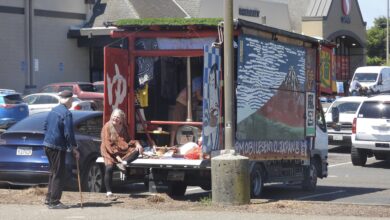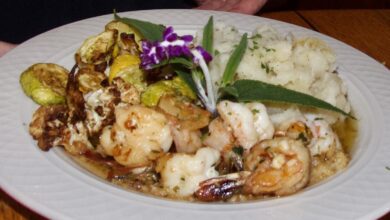Famous gardening author visits coast, recommends growing soil
Green gardening guru John Jeavons provided a gloomy message to a gathering organized by Coast Economic Localization Link (CELL) Saturday, March 11 about the future of market-based agriculture on a planet with a steadily worsening population problem.
More than 150 people overflowed the Mendocino Community School to hear the renowned Willits author deliver two hours” of statistics and a brief look at his remedy he calls bio-intensive farming.
The principle is to invigorate and reuse more soil and to grow communities of organisms from compost to healthy vegetables on a smaller surface area.
In an inimitable professorial style, Jeavons showed slides that repeatedly pointed out that chemical-based and even sustainable and organic farming is depleting the world”s soils, and that growing crops that bring the highest price will starve the future.
Jeavons is the author of “How to Grow More Vegetables Than You Ever Thought Possible On Less Land Than You Can Imagine.” He operates the nonprofit Ecology Action and has a Website at www.johnjeavons.info.
Jim Tarbell of Caspar said Jeavons has long been an icon of the movement for more responsible growing practices. Tarbell has been familiar with the author since he was a young hippie who wanted to live off the land.
“I”ve read and known about John Jeavons for about 30 years and never seen him so I wanted to come out tonight and see what he looks like,” said Tarbell.
Jeavons wore a hat and had a inscrutable deadpan style that was free of politics and heavy on statistics. The highlight of his presentation was when he ate a spoonful of applesauce ? then demonstrated how much soil that “pound” of food cost the planet. He did that by shoveling six tablespoons (pounds) of dirt into a bowl saying U.S. chemical fertilizer-based agriculture uses up six pounds of topsoil for every pound of food produced.
In a community where banana slugs and powdery mildew are a greater problem for farmers than large corporate farms and clouds of herbicides, the world population nightmare script seemed more geared to a Central Valley audience.
Members of the crowd implored Jeavons for more details on the solutions, like how to make the compost and how to deal with specific soil challenges.
“It may seem a little slow, but if I just tell you the answer, you might lack the motivation to use it,” he said when people pushed him to cut to the specifics.
Jeavons” big picture
While Jeavons” famous book is very specific on how to feed plants, test soil and plant, Jeavons” talk was more of a missionary effort to get people to see the big picture in every contact they have with the earth.
He said disaster plans in places like San Francisco call for an exodus to places like Mendocino County. He said each person in Mendocino County might someday find themselves with two Bay Area residents to feed.
He said bio-intensive methods will grow two to six times more food and are not the same as sustainable practices, which simply grow the crops the market wants using better methodology, although often borrowing from soils in other areas. Jeavons” vision is a world where food is created locally using local resources and does not rely on borrowing resources from soils in other areas.
While he insisted his plan is not a panacea, he said the answer to earth”s problems are everywhere. He described how there are 6 billion microbes in a clump of compost that will fit in the palm of your hand ? nearly the same as the human population of the Earth.
Like a professor unraveling a complex syllabus to his class, he told the audience that the most important thing they could do for the planet is to stop growing crops and grow soil. He then said they should stop growing soil and start growing more people who know the importance of growing soil.
His sense of humor was often that of a college professor, as in the appearance of a human head where an artichoke should be when he talked about the need to grow more humans who know the importance of growing soil.
Many of the practices that Jeavons preaches are throwbacks to old-fashioned farming, in the days when farming was primarily based on community, not capital.
For example, wind-break rows of trees, which were used nearly universally by old school farmers across America in the 18th, 19th and early 20th centuries, were ripped out in most of the American Midwest starting in the last half of the 20th century, to allow for a few extra rows of crops to be grown and larger tractors to be used. This came at the expense of large amounts of topsoil lost to erosion.
The continued drive to maximize profits above all else in the late 20th century isn”t confined to America ? developing countries are twice as bad at causing soil erosion in the global competition to raise the highest dollar crops, regardless of local food needs. Jeavons used 12 spoons of soil to illustrate the cost of one spoon of food in the developing world.
Crop rotation and the resting of fields, mandated in the Bible and practiced until the advent of corporate agriculture, along with the disadvantages of scientific hybridization and super pesticides are part of Jeavons” message. So saving seeds that produce true to type with open pollination ? rather than the unpredictable offspring of hybrids.
While he said a vegan diet is better for the planet than an animal-based diet, he said repeatedly he wasn”t anti-animal. Plunking an apple into his mouth to symbolize the end of the Earth”s capacity to produce food for its people, he said that would happen in 38 to 76 years, depending on whether current practices are modified. He said if everyone in the U.S. switched to a vegan diet, the food would last 39.5 years instead of 38.
Much of the crowd was familiar with his work and had come to learn more of the gardening techniques.
“I have read most of his books and I”m here to get some answers to the nightmares out there,” said John Canfield of Comptche.
CELL”s goals
CELL is energizing action to organize work parties to go to different homes to promote creating raised beds or compost piles of the type Jeavons describes in his book.
One effort hopes to get people locally to eat only food grown within a 100-mile “food shed” for a month, possibly October, CELL member Marty Johnson said.
“It will involve identifying at local markets what foods are grown or processed within 100 miles, classes on canning and preserving, educational programs for the schools, and inviting different restaurants to showcase meals with local foods,” Johnson said.
CELL is also working on developing a map that will show local micro-climates, the food infrastructure, viable agriculture land, energy infrastructure and water resources.
“I am also working with other communities who are developing questionnaires. I will look forward to having others on the coast who may be interested in joining us as we work on this project which I think will be ongoing in its development and refinement,” he said.
More information about CELL is online at localize@mcn.org.




